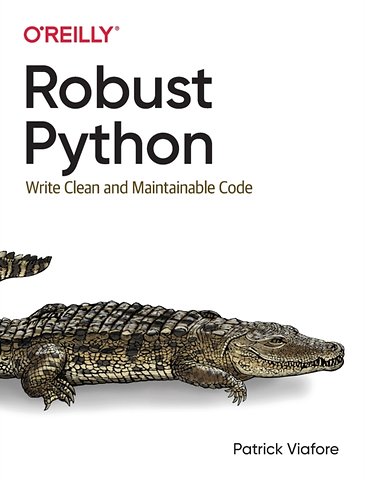Robust Python
Write Clean and Maintainable Code
Paperback Engels 2021 1e druk 9781098100667Samenvatting
Does it seem like your Python projects are getting bigger and bigger? Are you feeling the pain as your codebase expands and gets tougher to debug and maintain? Python is an easy language to learn and use, but that also means systems can quickly grow beyond comprehension. Thankfully, Python has features to help developers overcome maintainability woes.
In this practical book, author Patrick Viafore shows you how to use Python's type system to the max. You'll look at user-defined types, such as classes and enums, and Python's type hinting system. You'll also learn how to make Python extensible and how to use a comprehensive testing strategy as a safety net. With these tips and techniques, you'll write clearer and more maintainable code.
- Learn why types are essential in modern development ecosystems
- Understand how type choices such as classes, dictionaries, and enums reflect specific intents
- Make Python extensible for the future without adding bloat
- Use popular Python tools to increase the safety and robustness of your codebase
- Evaluate current code to detect common maintainability gotchas
- Build a safety net around your codebase with linters and tests
Specificaties
Lezersrecensies
Inhoudsopgave
Who Should Read This Book
About This Book
Conventions Used in This Book
Using Code Examples
O’Reilly Online Learning
How to Contact Us
Acknowledgments
1. Introduction to Robust Python
Robustness
Why Does Robustness Matter?
What’s Your Intent?
Asynchronous Communication
Examples of Intent in Python
Collections
Iteration
Law of Least Surprise
Closing Thoughts
I: Annotating Your Code with Types
2. Introduction to Python Types
What’s in a Type?
Mechanical Representation
Semantic Representation
Typing Systems
Strong Versus Weak
Dynamic Versus Static
Duck Typing
Closing Thoughts
3. Type Annotations
What Are Type Annotations?
Benefits of Type Annotations
Autocomplete
Typecheckers
Exercise: Spot the Bug
When to Use Type Annotations
Closing Thoughts
4. Constraining Types
Optional Type
Union Types
Product and Sum Types
Literal Types
Annotated Types
NewType
Final Types
Closing Thoughts
5. Collection Types
Annotating Collections
Homogeneous Versus Heterogeneous Collections
TypedDict
Creating New Collections
Generics
Modifying Existing Types
As Easy as ABC
Closing Thoughts
6. Customizing Your Typechecker
Configuring Your Typechecker
Configuring mypy
Mypy Reporting
Speeding Up mypy
Alternative Typecheckers
Pyre
Pyright
Closing Thoughts
7. Adopting Typechecking Practically
Trade-offs
Breaking Even Earlier
Find Your Pain Points
Target Code Strategically
Lean on Your Tooling
Closing Thoughts
II: Defining Your Own Types
8. User-Defined Types: Enums
User-Defined Types
Enumerations
Enum
When Not to Use
Advanced Usage
Automatic Values
Flags
Integer Conversion
Unique
Closing Thoughts
9. User-Defined Types: Data Classes
Data Classes in Action
Usage
String Conversion
Equality
Relational Comparison
Immutability
Comparison to Other Types
Data Classes Versus Dictionaries
Data Classes Versus TypedDict
Data Classes Versus namedtuple
Closing Thoughts
10. User-Defined Types: Classes
Class Anatomy
Constructors
Invariants
Avoiding Broken Invariants
Why Are Invariants Beneficial?
Communicating Invariants
Consuming Your Class
What About Maintainers?
Encapsulation and Maintaining Invariants
Encapsul-what, Now?
Protecting Data Access
Operations
Closing Thoughts
11. Defining Your Interfaces
Natural Interface Design
Thinking Like a User
Natural Interactions
Natural Interfaces in Action
Magic Methods
Context Managers
Closing Thoughts
12. Subtyping
Inheritance
Substitutability
Design Considerations
Composition
Closing Thoughts
13. Protocols
Tension Between Typing Systems
Leave the Type Blank or Use Any
Use a Union
Use Inheritance
Use Mixins
Protocols
Defining a Protocol
Advanced Usage
Composite Protocols
Runtime Checkable Protocols
Modules Satisfying Protocols
Closing Thoughts
14. Runtime Checking With pydantic
Dynamic Configuration
pydantic
Validators
Validation Versus Parsing
Closing Thoughts
III: Extensible Python
15. Extensibility
What Is Extensibility?
The Redesign
Open-Closed Principle
Detecting OCP Violations
Drawbacks
Closing Thoughts
16. Dependencies
Relationships
Types of Dependencies
Physical Dependencies
Logical Dependencies
Temporal Dependencies
Visualizing Your Dependencies
Visualizing Packages
Visualizing Imports
Visualizing Function Calls
Interpreting Your Dependency Graph
Closing Thoughts
17. Composability
Composability
Policy Versus Mechanisms
Composing on a Smaller Scale
Composing Functions
Composing Algorithms
Closing Thoughts
18. Event-Driven Architecture
How It Works
Drawbacks
Simple Events
Using a Message Broker
The Observer Pattern
Streaming Events
Closing Thoughts
19. Pluggable Python
The Template Method Pattern
The Strategy Pattern
Plug-in Architectures
Closing Thoughts
IV: Building a Safety Net
20. Static Analysis
Linting
Writing Your Own Pylint Plug-in
Breaking Down the Plug-in
Other Static Analyzers
Complexity Checkers
Security Analysis
Closing Thoughts
21. Testing Strategy
Defining Your Test Strategy
What Is a Test?
Reducing Test Cost
AAA Testing
Closing Thoughts
22. Acceptance Testing
Behavior-Driven Development
The Gherkin Language
Executable Specifications
Additional behave Features
Parameterized Steps
Table-Driven Requirements
Step Matching
Customizing the Test Life Cycle
Using Tags to Selectively Run Tests
Report Generation
Closing Thoughts
23. Property-Based Testing
Property-Based Testing with Hypothesis
The Magic of Hypothesis
Contrast with Traditional Tests
Getting the Most Out of Hypothesis
Hypothesis Strategies
Generating Algorithms
Closing Thoughts
24. Mutation Testing
What Is Mutation Testing?
Mutation Testing with mutmut
Fixing Mutants
Mutation Testing Reports
Adopting Mutation Testing
The Fallacy of Coverage (and Other Metrics)
Closing Thoughts
Index
Anderen die dit boek kochten, kochten ook
Rubrieken
- advisering
- algemeen management
- coaching en trainen
- communicatie en media
- economie
- financieel management
- inkoop en logistiek
- internet en social media
- it-management / ict
- juridisch
- leiderschap
- marketing
- mens en maatschappij
- non-profit
- ondernemen
- organisatiekunde
- personal finance
- personeelsmanagement
- persoonlijke effectiviteit
- projectmanagement
- psychologie
- reclame en verkoop
- strategisch management
- verandermanagement
- werk en loopbaan







